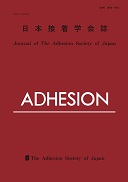All issues

Volume 38, Issue 7
Displaying 1-4 of 4 articles from this issue
- |<
- <
- 1
- >
- >|
Review
-
Masashi KAJI2002 Volume 38 Issue 7 Pages 262-268
Published: July 01, 2002
Released on J-STAGE: July 31, 2015
JOURNAL RESTRICTED ACCESSDownload PDF (1662K)
Original Paper
-
Masatsugu MURASE, Chiaki KATOH2002 Volume 38 Issue 7 Pages 255-261
Published: July 01, 2002
Released on J-STAGE: October 31, 2014
JOURNAL FREE ACCESSThe influences of electric potential at defect and NaCl concentration in aqueous solution for cathodic delamination were investigated in polyethylene coated steel pipe. The cathodic delamination kinetics and incubation time of cathodic delamination were calculated by using time dependability of cathodic delamination. The cathodic delamination kinetics became so large when electric potential at defects became disnoble and was proportional to electric potential at defect. That became so large when NaCl concentration in aqueous solution became higher and was proportional to the 0.15th power of NaCl concentration. The incubation time of cathodic delamination was greatly dependent on electric potential at defect. The cathodic delamination model was proposed by for polyethylene coated-steel.View full abstractDownload PDF (1769K)
Original Paper
-
Shoichi KIDO, Yoshihito SUZUKI, Toshiyuki SAWA2002 Volume 38 Issue 7 Pages 244-254
Published: July 01, 2002
Released on J-STAGE: October 31, 2014
JOURNAL FREE ACCESSThe stress wave propagation in butt adhesive joints of similar hollow cylinders subjected to impact tensile loadings are analyzed in elastic and elasto-plastic deformation ranges using a finite-element method. The impact loading is applied to the joint by dropping a weight. The upper end of the upper adherend is fixed and the lower adherend of which the lower end is connected to a guide bar is subjected to the impact loading. The FEM code employed is DYNA3D. The effect of the adhesive thickness and Young's modulus of the adhesive on the stress wave propagation at the interfaces are examined. In addition, the characteristics of the joints subjected to the impact loadings are compared with those of the joints under static loadings, and the strengths of the joints under static and impact loadings are estimated by using the interface stress distributions. It is found that the maximum value of the maximum principal stress occurs at the outside edge of the interface of the lower adherend to which the impact loading is applied. The maximum value of the maximum principal stress s1 increases as Young's modulus of the adhesive increases when the joints are subjected to impact loadings. It is found that the characteristics of the joints subjected to impact loadings are opposite to those subjected to static loadings. In addition, experiments were carried out to measure the strain response of the butt adhesive joints subjected to impact and static tensile loadings using strain gauges and the joint strength was also measured. Fairy good agreements are observed between the numerical and the measured results concerning the strain responses and the joint strengths.View full abstractDownload PDF (3182K)
Original Paper
-
Kazuya NAGATA, Shigeki HIKASA, Hideyuki NIGO, Kazuhiko MAEKAWA, Motots ...2002 Volume 38 Issue 7 Pages 237-243
Published: July 01, 2002
Released on J-STAGE: October 31, 2014
JOURNAL FREE ACCESSThe effects of some modifieirs on the interfacial structure and mechanical properties of ethylene–octene copolymer filled with Mg(OH)2 were studied. The modifiers used were ethylene-b-acrylate copolymer (PE-diblock) stearic acid (HSt), and maleic anhydride-Polyethylene(MAh-PE). The composites were prepared using a mixing roll. The modulus, yield strength, and elongation at break of the non-modified system were 5.5 MPa, 320 MPa and 550%, respectively. Those for the modified systems at a Mg(OH)2 content of 65wt% were 5.9 MPa, 200 MPa and 800% for PE-diblock, 2.8 MPa, 185 MPa and 790% for HSt, and 7.5 MPa, 220 MPa and 110% for MAh-PE, respectively. It was found that the PE-diblock-modified system poses the well-balanced mechanical properties. The analysis of their mechanical properties suggested that the modifiers existed at the particle/matrix interface. The superior mechanical properties of the PE-diblock-modified system expected to be brought by the own interfacial structure.View full abstractDownload PDF (2255K)
- |<
- <
- 1
- >
- >|